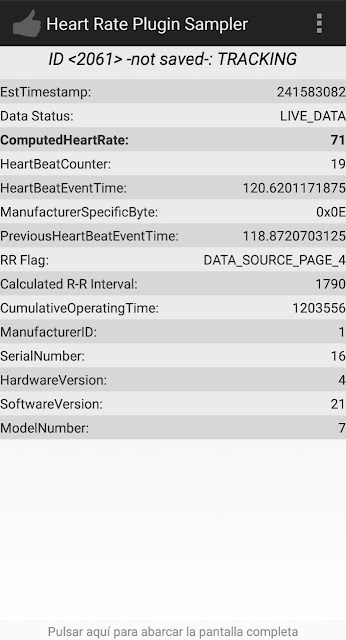Estas ideas llevaron a buscar más información sobre el artista y su arte performance. Y luego a encontrar páginas y referencias como por ejemplo
martes, 19 de enero de 2021
Ideas prohibidas (Das Orgien Mysterien Theater)
Estas ideas llevaron a buscar más información sobre el artista y su arte performance. Y luego a encontrar páginas y referencias como por ejemplo
lunes, 11 de enero de 2021
heart rate variability (HRV)
heart rate variability (HRV) based analysis
desde 2017/10/09
En 2017 comencé a escuchar esta idea sobre la variabilidad del ritmo cardíaco. Sin embargo, no lo había revisado a fondo. Es más, hasta ahora no entiendo los pormenores del método.
Hoy lo revisé brevemente y publico el siguiente resumen:
Heart Rate Variability.
Heart Rate Variability reflects how strong your recovery system—the parasympathetic nervous system—is currently.
Heart Rate Variability is a far more sensitive measure of the status of the autonomic nervous system.”
Heart Rate Variability could only be tracked via a lab-grade EKG assessment
heart rate chest straps tend to be most accurate.
tracking Heart Rate Variability for at least a month (during a regular training cycle) to establish what your “normal” range should be.
How Heart Rate Variability Is Measured
resting HR is 60 bpm. A Heart Rate Variability-calculating device measures the interval between each of those beats, in milliseconds, over a specific period of time, like five minutes, then crunches the numbers to assign a Heart Rate Variability score. If the intervals between beats are about the same, your HRV score will be low, indicating you need to take it easy.
If it varies, your score will be higher, and you’re ready to rock.
When it is LOW, it will take the body longer to recover from hard sessions and it indicates to the athlete that they need to spend more time recovering.
Conversely, when it is HIGH, an athlete will bounce back from intense work much more quickly.
https://www.triathlete.com/training/heart-rate-variability/
siguientes pasos incluyen buscar aplicaciones de código abierto que permitan calcular estos valores tomando como base los datos proporcionados por un dispositivo de pecho con interfaz radio ANT+ y un smartphone compatible.
posiblemente utilizando el valor calculado de intervalo R-R.
¿Qué opinan?
pcap Packet Capture
https://documentation.meraki.com/MR/WiFi_Basics_and_Best_Practices/802.11_Association_process_explained
Problemas con instalación de wireshark, tshark, wireshark-common. visitar:
https://blog.bravi.org/?p=912
http://wiki.pchero21.com/wiki/Wireshark
para generar archivos de 1 minuto circular y filtrar el tráfico es udp:
$ sudo dumpcap -b duration:60 -b files:5 -i eth2 -w /tmp/salida.pcap -f "udp port 37008"
192.168.88.1
Para leer el tráfico usar
- tcpdump
- tshark
filtrar tipos especificos
- para una lista de los tipos y subtipos verificar:
https://sharkfest.wireshark.org/sharkfest.10/B-5_Parsons%20HANDS-ON%20LAB%20-%20WLAN%20Analysis%20with%20Wireshark%20&%20AirPcap%20Exercises.pdf
Tipo
wlan.fc.type==0 Management
por ejemplo :
tshark -r salida_00002_20171124155427.pcap -Y 'wlan.fc.type==0 && wlan.fc.type_subtype==4'
ver https://www.wireshark.org/docs/wsug_html/#AppToolsdumpcap
AC:3C:0B:EA:E4:CB
5C:A3:9D:18:E2:B9
5C:A3:9D:18:E2:B9
01:00:5E:7F:FF:FA
00:27:19:1D:C1:94
$ ./tshark -lr clean-test02.cap -o column.format:"rhs","%rhs","uhs","%uhs" | sort | uniq
Cisco_8f:2c:95 00:19:2f:8f:2c:95
Estos comandos permiten generar una herramienta de "espionaje" al guardar las direcciones MAC de dispositivos con su Wi-Fi encendido.
La información espacio-temporal permitiría establecer perfiles al analizar varios puntos geográficos de detección de determinada dirección.
Esta técnica se usa para generar perfiles de los usuarios para caracterizar el uso del transporte público.
Ver artículos doi: 10.1109/etcm.2018.8580283 y doi: 10.1109/ETCM48019.2019.9014911 para más información.
